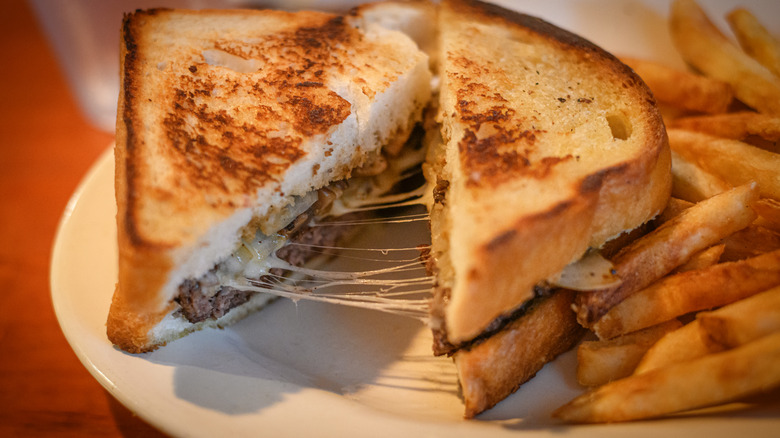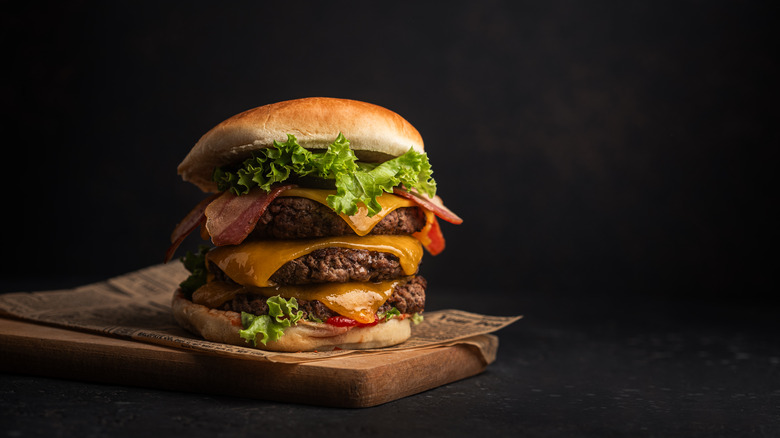Burgers Vs Patty Melts: What's The Difference?
If you grew up in the South, chances are that you've come across Waffle House's late-night patty melt, preferably served with scattered, smothered, and covered hash browns — basically a special order of crispy hash browns covered in cheese and onions. Likewise, the patty melt is a beef patty, smothered in cheese and caramelized onions and sandwiched between two pieces of grilled toast. Say what you will about Waffle House, but any restaurant chain with its own museum obviously has something going for it. And this Southern fixture's patty melts are hard to beat. In fact, because of this, many diners claim it can beat a plain old burger any day.
Of course, that begs the question: Is there really any difference between a burger and a patty melt? At their core, they're two different dishes. Sure, these culinary cousins may share some ingredients, like ground beef and cheese, sometimes even onions, but that's as far as it goes. Where a hamburger is sometimes unwieldy — with a panoply of flavors and textures from its various add ons and condiments — the patty melt is more compact. All the tastes and textures work in tandem to produce an umami-laden, crispy yet juicy eating experience enlivened by a touch of sweetness from the onions. In fact, a patty melt is more akin to a grilled cheese than a hamburger. Let's dig a little deeper into the differences between a burger and a patty melt.
The burger's melange of flavors and textures
The evolution of the hamburger began in the mid-19th century with an influx of German immigrants to the United States who popularized "Hamburg-style" chopped steak. At the turn of the century, someone had the novel idea of putting these beef patties on a bun and the hamburger as we know it was born, with the 1904 St. Louis World's Fair helping to popularize the sandwich. It didn't take folks long to begin to add all kinds of things to the dish, from cheese to pickles to lettuce to ketchup, mustard, and mayonnaise.
The potential for overfilling the burger is real. The late author, chef, and TV personality Anthony Bourdain even came up with a one hand-rule for better burgers. In his opinion, you should be able to eat a hamburger with one hand and still get a representative taste of all the ingredients. There's plenty to love in a good burger with gooey cheese, crisp lettuce, pungent raw onion, crunchy pickles, tangy mustard, creamy mayonnaise, and sweet ketchup. But it is a very different experience than eating a patty melt. It's more like hearing a full choir where the patty melt is closer to a three-part harmony.
A diner staple, but not a burger
The history of the patty melt begins in the 1940s with William Wallace "Tiny" Naylor, who is credited with the sandwich's invention. Served at his San Francisco establishment called Tiny's Waffle Shop, the original incarnation involved a beef patty, caramelized onions, Swiss cheese, on sourdough bread. When Naylor moved his business to Los Angeles, he switched to rye bread, and to this day, that's continued to be the standard. Patty melts became a typical diner menu item, but unlike the hamburger, never took off with the rise of American fast food chains in the 1950s.
At a diner, a patty melt is made on a buttered griddle (rather than the grill, the hamburger's famed cooking spot) with all the ingredients melding into a flavorful whole. A home chef can make it in a single frying pan, but if you're working in a small space, you'll have to do it in steps. But by the end, the beef, cheese, onions, butter, mayo, and bread can become a compact, super-flavorful sandwich that is crisp, unctuous, smoky, and savory-sweet. We're not alone in the belief that a patty melt is fundamentally different from a hamburger. In "The Hamburger: A History," the late author Josh Ozersky clearly designated them as different when he said that the hamburger, unlike the patty melt, is the quintessential American sandwich. And while that may be true, those who have had the diner item have a special place in their hearts for the unsung patty melt.


